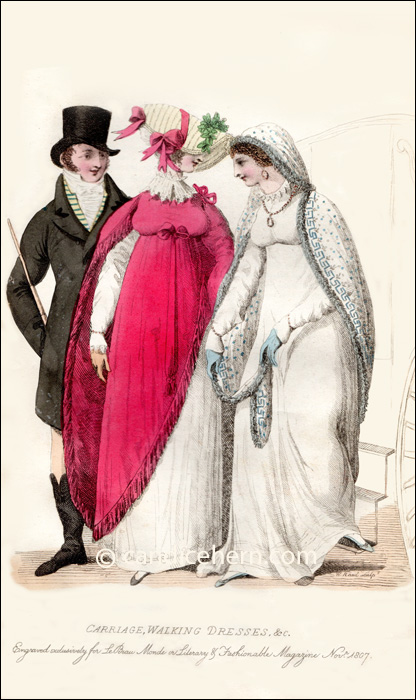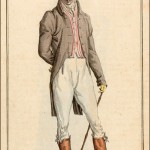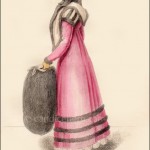Le Beau Monde, November 1807.
“Carriage, Walking Dresses, &c.”
 The lady on the right is described as wearing a “Carriage Full Dress.” That does not make much sense considering that a carriage dress is for traveling and full dress is for formal evening wear. Though the satin cloak is fur-trimmed and quite elegant, the muslin dress is simple, and the jewelry is the sort worn with day wear. Perhaps her ensemble was meant to be worn while driving about town in the late afternoon, during the time to see and be seen, and not for long journeys. If that were true, though, she would more likely be in an open carriage instead of the closed carriage hinted at in the print. In any case, I think we can assume that the term “Full” in this case has nothing to do with evening full dress. And perhaps the artist got the carriage wrong!
The lady on the right is described as wearing a “Carriage Full Dress.” That does not make much sense considering that a carriage dress is for traveling and full dress is for formal evening wear. Though the satin cloak is fur-trimmed and quite elegant, the muslin dress is simple, and the jewelry is the sort worn with day wear. Perhaps her ensemble was meant to be worn while driving about town in the late afternoon, during the time to see and be seen, and not for long journeys. If that were true, though, she would more likely be in an open carriage instead of the closed carriage hinted at in the print. In any case, I think we can assume that the term “Full” in this case has nothing to do with evening full dress. And perhaps the artist got the carriage wrong!
The male and central female are both attired in Morning Walking Dress.
The print is signed by the engraver, William Read, a popular London engraver from the early 19th century through the 1840s.
The print is described in the magazine as follows:
“A MORNING WALKING DRESS. A Danish robe and mantle is formed of beautiful carmine soft satin shot with white; the mantle is made with two gores and one seam behind, the left arm being confined in a long sleeve of the same; the back is straight and easily fulled on the right shoulder, together with the robe leaving an arm hole, from thence the mantle and robe is fastened together to the bottom, with about a quarter in breadth of the mantle flying off. The front of the robe is tastefully sloped off from the left side to the length of the mantle, which nearly reaches the bottom of the dress. The robe is brought straight over the bosom, and fastens to the mantle, with a small bunch of carmine ribbon on the top of the left shoulder, and confined under the arm, leaving the mantle to hang loose down the sides. A rich broad ribbon of the same colour is fastened to the back of the mantle outside, and brought through on each side, confines the robe, tied in the center of the waist with two bows with long ends and tassels suspended before. This robe and mantle is trimmed all round with a superb floss silk trimming, half a quarter wide; a rich Vandyke lace frill, made very deep, is worn round the throat. A plain round muslin dress, walking length, ornamented round the bottom with a rich border of fancy needlework, made in the chemise fashion, with long full sleeves, trimmed round the neck and at the wrists with Vandyke lace. The Danish bonnet worn with this dress is made of rich satin straw, ornamented with a simple flower tastefully disposed across the front, trimmed with a rich broad ribbon of the same colour as the robe, with a small white sarsnet bag behind to confine the hair [a footnote below reads: “This straw bonnet is to be had only at Millard’s, corner of Southampton-street, Strand.”]; Limerick gloves and black kid shoes.
“CARRIAGE FULL DRESS. A rich Cardinal cloak, composed of white satin, stamped with small blue flowers, ornamented round the edge with an Egyptian border of the same, enriched with a superb Hungarian fur trimming. This cloak is made similar to that of a loose drapery worn over the head and shoulders, carelessly caught back between the neck and the shoulder, which forms a hood on one side, and continues to hang in loose drapery down the other, with one corner rounded off small, and held in the hand. A plain India muslin dress made all in one and straight over the bosom; a square back drawn round the throat and at the bottom of the waist with bunches of white sarsnet ribbon; the neck of the dress is enriched round the throat with a Vandyke lace, ornamented round the bottom with three rows of hem-stitch richly worked; long loose sleeves confined round the wrist with coral bracelets; necklace and ear-rings to correspond; the hair is worn on the left side of the forehead in a thick cluster of small plaits, and large flat curls on the other side of the face; glove blue kid; and shoes blue satin.”
The gentleman’s ensemble is not described specifically, but the following note in the section labeled Gentlemen’s Dress seems to fit the gentleman shown in the print:
“THE MORNING COATS still run on the greenish olive or mixtures; and though it is doubtful whether they are mostly double breasted or single, they are constantly seen with plain plated buttons and collars of the same cloth, and made without pocket flaps, the pockets being put in the plaits behind. Striped toilinet waistcoats, of char [?] distinct stripes, bound with silk binding. Drab kerseymere breeches to come down over the knee with gilt buttons, and brown top boots, or pantaloons of the same description of colour, and Hussar boots.”







